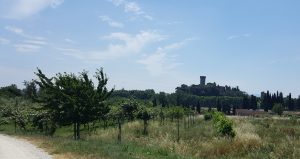
While vineyard tours are plentiful, fascinating and fun, after your third or tenth tour you might be looking for a different way to spend a day.
I would highly recommend visiting an olive farm that produces its own oil.
I discovered this while planning last year’s Book Club in Tuscany trip. One of the books we were reading was “Extra Virginity” about the olive industry and how to tell good oil from bad. I wanted to have a day trip focused on olive oil, but just a tasting at a shop in town wasn’t very “immersive.” Good thing the trusty interwebs pointed me to Il Frantoio di Vicopisano del Rio Grifone, an olive farm east of Pisa on the Rio (river) Grifone.
I contacted them, set up a tour, tasting and lunch, then crossed my fingers that the place was all it said it was on their website.
It was all that e molto di piu!
The day we went was cool-to-warm and sunny, which showcased the beautiful drive to the farm. Winding roads through the countryside, through small towns and past vineyards. We put the name of the farm into our navigation system and it took us right there. When we got close, we saw a medieval tower that sits just across from the farm (above). It was designed by Brunelleschi, the man who designed the famous Duomo in Florence.
Turning in at the sign, we drove up a road surrounded on each side by fields of fruit trees. On the hillside beyond those fields was row after row of mature frantoio olive trees.
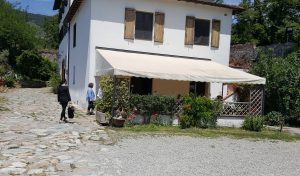 At the end of the road were a few buildings and a two-story white stucco house with a covered porch. Waiting for us there was Marco, our tour guide for the day and the eventual crush of every woman in our group. Handsome, smart and charming.
At the end of the road were a few buildings and a two-story white stucco house with a covered porch. Waiting for us there was Marco, our tour guide for the day and the eventual crush of every woman in our group. Handsome, smart and charming.
The tour started with a refreshing glass of what tasted like a homemade sangria — various fruits in a chilled white wine. While enjoying that, we met a couple from London who had rented the apartment on the farm – yes you can do that – for a month. They said it was the ideal hub for their Tuscan sightseeing and on some days they just hung out at the farm, taking walks, reading, napping. They looked more relaxed than I do when I’m asleep.
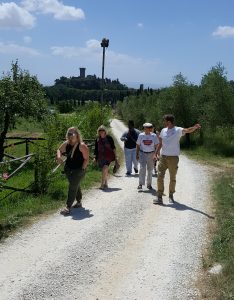 It was time for our tour! Marco began by walking us back down the road we’d driven up. The fruit trees we saw were, surprisingly enough, kiwi trees. There were also peaches, pears, apricots and figs, along with organic vegetable and herb gardens. The kiwis are used to make “Kiwino” – a light liqueur — and gobbledy-good kiwi jam. More on that later.
It was time for our tour! Marco began by walking us back down the road we’d driven up. The fruit trees we saw were, surprisingly enough, kiwi trees. There were also peaches, pears, apricots and figs, along with organic vegetable and herb gardens. The kiwis are used to make “Kiwino” – a light liqueur — and gobbledy-good kiwi jam. More on that later.
When we got to the olive trees (all 2,500 of them organic), Marco explained why and how the trees are pruned along with how the workers gather the ripe olives. Instead of picking each individual olive, they put nets down under the tree and gently whack the branches with a long-but-lightweight paddle-looking tool. The ripe ones fall into the net.

When we got inside the mill where the oil is made, Marco showed us another old way of squishing the olives to get the oil. Flat woven baskets were filled with olives and stacked on top of each other beneath what looked like a big plunger. The plunger was screwed down and down until it mashed all the baskets together and the oil dripped down. This was an advancement over the stone wheel because all the pits and leaves stayed in the basket.
Today, it’s all done by space-age machines – a defoliator, decanter and centrifuge among others — that basically annihilate the olives until they give up their delicious green oil.
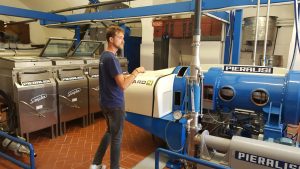 The Rio Grifone mill has all these machines, so during “the season” – which can span the October/November time frame depending on weather – several of the farmers in the area bring their olives there for processing. It’s a busy time, said Marco, but also fun as the whole community is working together to help each other and make the harvest a success.
The Rio Grifone mill has all these machines, so during “the season” – which can span the October/November time frame depending on weather – several of the farmers in the area bring their olives there for processing. It’s a busy time, said Marco, but also fun as the whole community is working together to help each other and make the harvest a success.
By that time, we knew all about how the olive oil got into the bottle, so we went for the tasting.
At Vicopisano, they not only make a scrumptious regular olive oil, they also have different-flavored oils that are great for cooking and enhancing certain foods. Lemon, rosemary, basil, pepper and garlic – each of these fruits or herbs is thrown in with the olives to be crushed and processed from the very beginning. The result is not just “infused” oils but buttery delicious, mouthwatering flavor sensations. In other words, really, really yummy. The basil is great on salads, the rosemary on steak or chicken, I use the lemon on seafood, and the garlic in some pasta dishes.
 To taste all of these, we were asked to put five little mounds of white rice on our plates and the different oils were dribbled atop each one. The rice was bland enough to let the flavor of the oil come through. Along with the oil tastings we had bottles of the estate’s red wine, Ceppato, a sangiovese that was exquisitely smooth and drinkable. We also got to taste the Grappa they make there, as well as the aforementioned kiwi jam and Kiwino.
To taste all of these, we were asked to put five little mounds of white rice on our plates and the different oils were dribbled atop each one. The rice was bland enough to let the flavor of the oil come through. Along with the oil tastings we had bottles of the estate’s red wine, Ceppato, a sangiovese that was exquisitely smooth and drinkable. We also got to taste the Grappa they make there, as well as the aforementioned kiwi jam and Kiwino.
Lunch was a vegetable-filled ribollita (soup/stew) with fresh bread ideal for dipping into the oils. After the meal, we went shopping. The store at Rio Grifone had everything for sale, and they can ship purchases to the U.S. when you — like me — buy more than you can cram into your suitcase.
As you can see, I loved this experience. We bookended it with a morning at the Leaning Tower, and a late afternoon nap. And I took two other groups while I was there last summer. I gave the flavored oils as Christmas gifts and now all the recipients want to order more. I still have a little of what I bought for myself, but it’s going fast. Details about what and how to order are on the website.


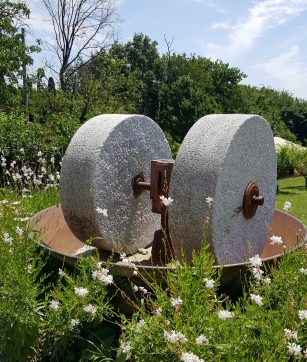

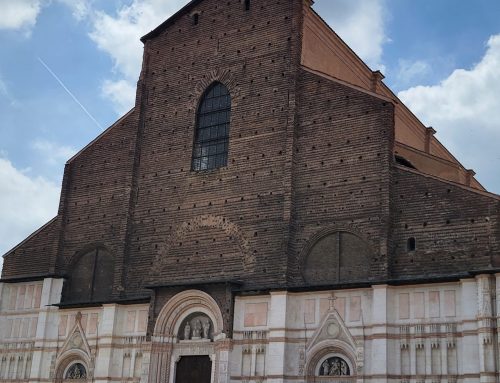


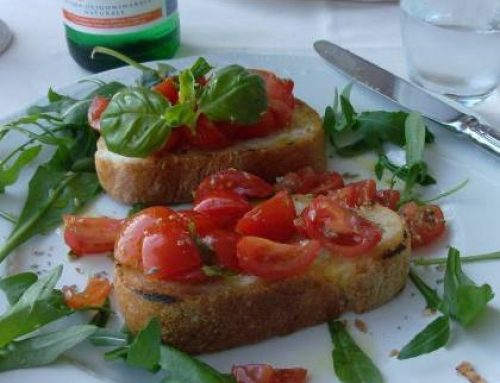
fuck google pokkerx.WRrZLM1VtZ6o
bahis siteleri porn sex incest mobileidn.QfSYaooioxCY
bahis siteleri incest category bingoxx.LUJSFzbLch07
fuck google 250tldenemebonusuxx.Ybrdy2BHxoDJ
anal siteleri eyeconartxx.Zu2zY71g4Z3s
eskort siteleri vvsetohimalxxvc.qPtRVQLLf2P3
eskort siteleri tthighereduhryyy.2lAw5WnJISa
Somebody essentially lend a hand to make significantly articles Id state That is the very first time I frequented your website page and up to now I surprised with the research you made to make this actual submit amazing Wonderful task
sex videos download hd ggjinnysflogg.4cPiND1NIyH
Wow, wonderful weblog structure! How lengthy have you ever been running a blog for?
you make blogging glance easy. The entire look of your website is excellent, as
smartly as the content! You can see similar here sklep internetowy
Wow, wonderful weblog format! How lengthy have you ever been blogging for?
you make running a blog look easy. The full look of your web site is excellent, as well as the content!
You can see similar here dobry sklep
Wonderful site you have here but I was curious about
if you knew of any message boards that cover the same topics discussed in this article?
I’d really like to be a part of group where I can get comments
from other experienced individuals that share the same interest.
If you have any suggestions, please let me know. Thanks!
I saw similar here: Sklep internetowy
Wow, wonderful blog format! How lengthy have you ever been running a blog for?
you made running a blog look easy. The overall glance of your web site is fantastic, let alone the content material!
You can see similar here ecommerce
Hey! Do you know if they make any plugins to help
with Search Engine Optimization? I’m trying to get my blog to
rank for some targeted keywords but I’m not seeing very good results.
If you know of any please share. Thanks! You
can read similar text here: Sklep internetowy
It’s very interesting! If you need help, look here: ARA Agency
It’s a pity you don’t have a donate button! I’d certainly donate
to this fantastic blog! I guess for now i’ll settle for
book-marking and adding your RSS feed to my Google account.
I look forward to new updates and will talk about this website with my Facebook group.
Talk soon!
Also visit my web site vpn code 2024
Yesterday, while I was at work, my cousin stole my apple ipad and
tested to see if it can survive a 40 foot drop,
just so she can be a youtube sensation. My iPad is now destroyed and she has 83 views.
I know this is entirely off topic but I had to share it with someone!
Also visit my blog post: vpn coupon 2024
fashionflag www free download porn video com fashionflag.AHkiRtrV89m
goodhere Gays porn vurucutewet.S7ixReYTzk1
ladyandtherose BDSM porn backlinkseox.4QbS4EJ1SxN
jenniferroy 熟女 (40 ) ポルノ japanesexxporns.7AYqeb0vTpL
landuse Fetish porn lancdcuse.IIYDa5qgZXE
falbobrospizzamadison Cumshot porn jkkıjxxx.awhBpX3e62o
Hey! Do you know if they make any plugins to assist with Search Engine Optimization? I’m trying to get my blog to rank for some targeted keywords but I’m not seeing very good
results. If you know of any please share. Kudos!
You can read similar text here: Sklep
कृष्ण श्वेत अश्लील qqyyooppxx.6ymmQV5Cit4
पीओवी पोर्न के बा hjkvbasdfzxzz.7lkahqy8F3g
Hello, I read your blog daily. Your story-telling style is awesome, keep doing what you’re doing!
Feel free to visit my site – vpn coupon 2024
It’s a shame you don’t have a donate button! I’d certainly donate to this excellent
blog! I guess for now i’ll settle for bookmarking and adding your RSS feed to my Google account.
I look forward to fresh updates and will share this
blog with my Facebook group. Talk soon!
Review my blog vpn special code
पुरुष हस्तमैथुन अश्लील txechdyzxca.LeUnD9ePPPK
विंटेज और युवा पोर्न hkyonet.kvk9Y0ZodHE
ਫੈਟਿਸ਼ ਪੋਰਨੋਗ੍ਰਾਫੀ ਹੈ madisonivysex.acUPWGlNdti
Hey! Do you know if they make any plugins to help with SEO?
I’m trying to get my website to rank for some targeted keywords but I’m
not seeing very good results. If you know of any please share.
Many thanks! I saw similar article here: Backlink Building
Good day! Do you know if they make any plugins to assist with
Search Engine Optimization? I’m trying to get my blog to rank for some targeted keywords but I’m not seeing very good success.
If you know of any please share. Thank you!
You can read similar blog here: Backlink Portfolio
Hi there! Do you know if they make any plugins to assist with SEO?
I’m trying to get my website to rank for some targeted keywords but I’m not seeing very
good results. If you know of any please share. Thanks!
I saw similar article here: GSA Verified List
ladesbet ਕਾਲੇ ਅਤੇ ਚਿੱਟੇ ਪੋਰਨੋਗ੍ਰਾਫੀ ladesinemi.YBLsQF4cPq9
ladesbet VRポルノ ladestinemi.l7GvTZSy3w6
Hey! Do you know if they make any plugins to assist with Search Engine Optimization? I’m trying to get my website to rank for some targeted keywords but I’m not seeing very
good success. If you know of any please share. Appreciate it!
I saw similar blog here: GSA List
This paragraph will help the internet viewers for building up new
web site or even a weblog from start to end.
Feel free to surf to my page … vpn coupon code 2024
Wow, superb weblog format! How lengthy have you ever been blogging for?
you made blogging look easy. The whole glance of your site is great, let alone the content material!
You can see similar here ecommerce
Your article helped me a lot, is there any more related content? Thanks!